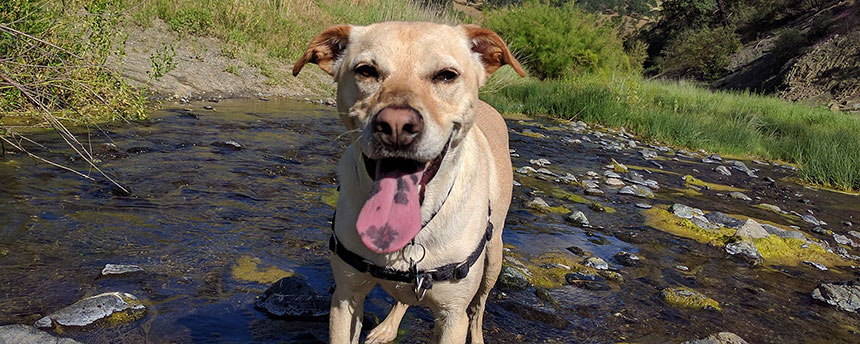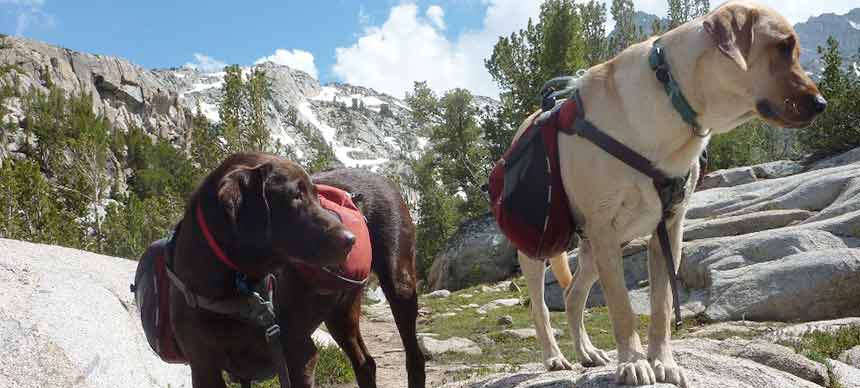More Outdoor Tips for Fido
- Keep fresh water available at all times.
- Know the location of the nearest emergency veterinary clinic while traveling.
- Know the risks for the area you are exploring.
- Microchip your pet.
- Protect paws from hot, rough surfaces (dog booties are great for long hikes over tough terrain).
- Create a go-bag for your pet that includes bottled water, record of current prescriptions and vaccination record and any first-aid treatment recommended by your veterinarian.
Summertime is made for hiking, swimming, camping and exploring. Often, our dogs are the best partners for those activities. They don’t ask “are we there yet?” every five minutes — they just stick their heads out the window and enjoy the journey. (OK, let’s be honest, every other dog but mine does this!)
There’s more to consider though than grabbing the leash and heading out the door if you want to avoid possible health problems and a visit to the vet. Here are a few key tips from the UC Davis School of Veterinary Medicine for keeping your dog safe on those Instagram-worthy summer adventures.
1. Avoid heatstroke
You’ve heard it a million times, but it bears repeating: Don’t leave your dog inside a parked car on a warm day. The inside of parked cars can reach dangerously high temperatures quickly and cause heatstroke when a dog’s body temperature rises (typically over 106 degrees Fahrenheit). As in humans, heatstroke can damage canine cell health and normal functions. Left untreated, it can kill.
Dogs are also susceptible to heatstroke when they exercise in warm weather and haven’t exercised a great deal in the colder months. You don’t go out and run a marathon the first day of summer when you have been keeping the couch warm all winter — and neither should your dog. Dogs at greater risk include those that are older, overweight or are brachycephalic (those cute, squishy-face breeds).
Karl Jandrey, associate professor of clinical small animal emergency and critical care at the UC Davis School of Veterinary Medicine, suggests easing into exercise, providing your dog access to plenty of water to drink and a safe body of water where they can cool off.
2. Prevent infectious disease

Speaking of those cool bodies of water that look so inviting when you’re hiking … some of them can harbor leptospirosis. This bacteria-caused disease can cause fever and kidney failure in dogs. Fortunately, there is a vaccine to help prevent your dog from getting leptospirosis, and it is recommended for dogs who spend a lot of time outdoors. Is your dog current on other vaccines too, including rabies?
Other infectious diseases are transmitted by fleas, ticks and mosquitoes. The most common mosquito-transmitted disease is heartworm. Jane Sykes, director of the UC Davis veterinary hospital, recommends keeping your dog on heartworm medication throughout the year as many mosquito varieties are active year-round. Some heartworm medications also help prevent fleas and ticks. Consult with a veterinarian for the best preventive care for your pet. (While rare, cats can also be infected by heartworm. Watch a recent heartworm removal from a cat — warning: not for the queasy viewer.)
Check your dog for ticks after a romp outdoors and if found, remove them promptly. Wear gloves if possible. Grasp the tick firmly with tweezers or curved forceps as close to the skin’s surface as possible. Pull upward with steady, slow pressure to ensure the tick's mouth parts do not break off in the skin. If that happens, wash area with disinfectant and watch carefully for signs of infection. If you see redness or swelling at the site, your dog should be checked by a veterinarian. Yes, dogs can be infected with Lyme disease, too.
3. Protect against snakebite

In California, we’re pretty lucky to have only one poisonous snake to avoid — the rattlesnake. The risk from these snakes is highest between April and October. A few tips to keep in mind:
- Keep away from areas with tall grass, rocks and wood piles.
- Stay on trails and keep your dog on a leash.
- Use a walking stick to rustle brush along trails to alert snakes of your presence. They don’t want to run into you either.
If your dog is bitten, Jandrey recommends getting it to the nearest veterinarian as quickly as possible. “A rattlesnake vaccine doesn’t necessarily prevent the need for medical attention or treatment."
4. Keep ID current

All pets need proper identification, particularly those who venture outside. Microchips, license tags, and tags with medical and contact information should be kept current for the best chance of reuniting with your pet should it get lost.
Keeping with our blog's One Health theme, read more about how to protect your pets and yourself from illness:
- What You — And Dogs — Can Do to Prevent Foodborne Illness
- 10 Garden Plants That are Toxic to Pets
- 5 Most Common Infectious Diseases From Your Pets
Trina Wood is the UC Davis School of Veterinary Medicine’s communications “Jill of All Trades,” a lover of animals who tells multimedia stories.